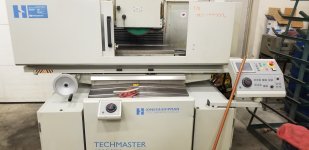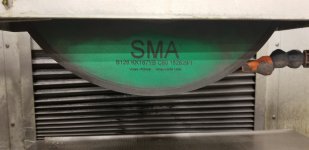Hi Everyone,
We just picked up a new (used) J&S CNC wetgrinder and it came with a big 'ol vitrified CBN wheel installed. This was a nice surprise, we grind a lot of K360 material which can be fairly challenging so we're hoping this helps make it a bit easier. None of us here have any real experience grinding with CBN so I'm just looking for some advice to make sure we are on the right track.


My first question would be, as far as using this wheel for grinding tool steel are there any precautions we should be aware of? Assuming it should be fine to run it similar to an Aluminum Oxide wheel on a wet grinder, light downsteps and bigger cross feed passes?
I can see a part number written on the wheel, and I can find a company called "SMA Abrasives" but I can't find any other info when I try to google the part numbers on the wheel. As least the surface speed is listed which is nice. Does anyone have any idea what grit this wheel would be?
Seems like the machine was used with coolant, is it ok to grind dry?
The other questions I have are related to dressing this wheel. Haven't checked yet, but since the wheel is already installed I'm assuming it is running true to the spindle currently.
Looking through all the past threads regarding CBN wheels, it seems like the best option for dressing this would be a brake controlled or motorized dresser with a silicon carbide wheel installed. With a 2nd less desirable option being to use a piece of molybdenum or norbide as a dresser and then using a dressing stick to free up the bond. Thinking we might try making a simple motorized dresser ourselves, any other good options we should be aware of?
Is the step of using a dressing stick to open up the bond also recommended when using a brake/motorized dresser?
Thanks in advance for any help, I'm sure I will have more questions as we get this thing setup and start using it.
We just picked up a new (used) J&S CNC wetgrinder and it came with a big 'ol vitrified CBN wheel installed. This was a nice surprise, we grind a lot of K360 material which can be fairly challenging so we're hoping this helps make it a bit easier. None of us here have any real experience grinding with CBN so I'm just looking for some advice to make sure we are on the right track.


My first question would be, as far as using this wheel for grinding tool steel are there any precautions we should be aware of? Assuming it should be fine to run it similar to an Aluminum Oxide wheel on a wet grinder, light downsteps and bigger cross feed passes?
I can see a part number written on the wheel, and I can find a company called "SMA Abrasives" but I can't find any other info when I try to google the part numbers on the wheel. As least the surface speed is listed which is nice. Does anyone have any idea what grit this wheel would be?
Seems like the machine was used with coolant, is it ok to grind dry?
The other questions I have are related to dressing this wheel. Haven't checked yet, but since the wheel is already installed I'm assuming it is running true to the spindle currently.
Looking through all the past threads regarding CBN wheels, it seems like the best option for dressing this would be a brake controlled or motorized dresser with a silicon carbide wheel installed. With a 2nd less desirable option being to use a piece of molybdenum or norbide as a dresser and then using a dressing stick to free up the bond. Thinking we might try making a simple motorized dresser ourselves, any other good options we should be aware of?
Is the step of using a dressing stick to open up the bond also recommended when using a brake/motorized dresser?
Thanks in advance for any help, I'm sure I will have more questions as we get this thing setup and start using it.

